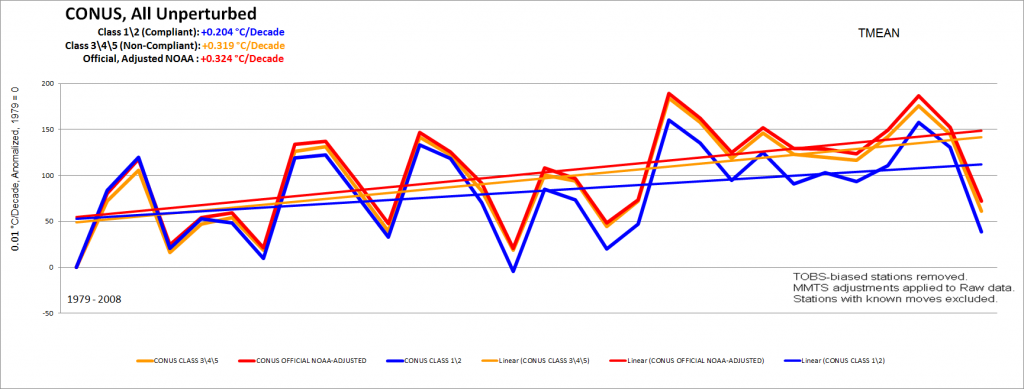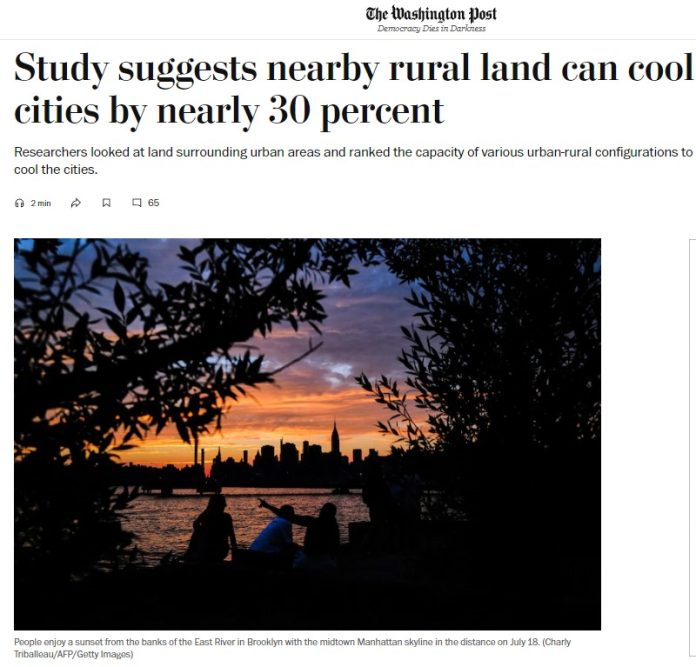An August 3rd article in The Washington Post (WaPo), “titled Study suggests nearby rural land can cool cities by nearly 30 percent,” admits what others, including The Heartland Institute, have noted for years: rural areas are much cooler than cities. What is new is they are suggesting that the rural areas actually keep the cities cooler by transport of cooler air from the rural regions into the city. They write:
Rural land surrounding urban areas could help cool cities by up to 32.9 degrees Fahrenheit, an analysis in Nature Cities suggests, hinting at a way to cool increasingly scorching urban areas.
In an attempt to understand how rural land cover affects urban heat islands — a phenomenon in which cities become significantly warmer than the areas surrounding them — researchers studied data from 30 Chinese cities between 2000 and 2020. They looked at land cover surrounding the urban areas and ranked the capacity of various urban-rural configurations to cool the cities.
Note the bolded 32.9 degrees Fahrenheit from the WaPo story. We’ve often said that journalists don’t have a clue about the most basic science, much less complex climate science. In this story WaPo reporter Erin Blakemore makes this abundantly clear.
The study press release from the University of Surrey referenced in the WaPo story says: “Rural belts around cities can reduce urban temperatures by over 0.5°C.”
Why the difference? Apparently the WaPo reporter can’t convert between Celsius and Fahrenheit correctly, due to an attempt to “Americanize” the story, she wanted to display the temperature in Fahrenheit, used in the United States.
If you don’t know the formula, you can use Google to do it, which is what she likely did. With Google 0.5°C converts to 32.9°F.
But that’s clearly wrong, because Blakemore is assuming that 0.5°C is an absolute temperature, rather than a difference in temperature due to the cooling effect between rural and city areas. If what she said were true, a pleasant city temperature of 65°F would be impossibly cooled down to 32.1°F (nearly freezing) by the effect of nearby rural areas. How embarrassing.
Despite this laughable failure of grade-school science, the WaPo story does point out the mechanism for how rural areas help keep cities cooler. The study, done in China says that heat is transported from the cities to the rural areas through a meteorological mechanism. The reason is a matter of physics, they write:
Air warms in cities, leaving a low-pressure zone near the ground that then helps transport cooler air from surrounding rural areas. The rural areas then go on to absorb the heat.
The study has implications for very large cities which often set new high temperature records when surrounding cities do not. The Urban Heat Island (UHI) effect has been known for quite some time, as shown in the illustration below.
From Climate at a Glance, Urban Heat Islands we know:
- Urban heat islands, which grow along with the size of cities, create artificial warming at many long-term temperature stations.
- On average, urban heat islands increase the global surface temperature trend by almost 50 percent.
- Nearly 90 percent of U.S. temperature stations have been compromised by urbanization effects.
- Almost half of the reported U.S. warming disappears when reporting only stations uncorrupted by heat islands.
One of the biggest issues with UHI is how it affects the surface temperature record for the planet.
The data in the figure below show temperature stations that have not been corrupted by the urban heat island effect report significantly less warming than temperature stations corrupted by urban heat island impacts, as seen in Figure 1, below. Still, despite this well-known problem, corrupted temperature stations compose a majority of the stations used to report official U.S. temperature data.

The biggest UHI issue is the fact that the thermometers located in cities tend to bias the trend of “global warming” upward, because cities are over-represented in the temperatures station record as a percentage of the Earth’s surface area. Rural areas where thermometers have not been compromised by UHI have a far lower 30 year trend in temperature.
It’s good that the UHI is finally being recognized by the WaPo, but given the scientific skill level displayed by the writer of this story it is doubtful they will ever figure how badly the UHI is biasing the surface temperature record which they find so alarming. I sadly expect WaPo and its science illiterate writers to continue to push the climate narrative blaming carbon dioxide produced by human fossil fuel use for causing a climate catastrophe, despite the mounting evidence that the recent temperature rise, properly measured, is unalarming.



















That was really pathetic that they couldn’t convert 0.5C degree change to Fahrenheit! They don’t know that a 1C degree change is 9/5F which is 1.8F degrees so for a 0.5C change it’s 0.9F degree difference! Also not knowing about the heat island effect is also very incredulous which says don’t trust anything the WaPo says as they apparently don’t have any scientific people involved in their studies who have a clue about what they’re talking about!
That is funny , but the problem , of course was failing to understand ` change rather than value .
BTW , I keep the words
` c>f :??
(
./CoSy/Furniture.f
: c>f ( fv — fv ) 1.8 _f *f 32. _f +f ; | centigrade to farenheit | 20141124
: f>c ( fv — fv ) 32. _f -f 1.8 _f %f ; | farenheit to centigrade | 20141124
)
Around in CoSy for whenever the instance strikes . They work on whole arrays .